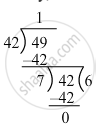Advertisements
Advertisements
Question
Three pieces of timber, 42-m, 49-m and 63-m long, have to be divided into planks of the same length. What is the greatest possible length of each plank?
Solution
The lengths of the three pieces of timber are 42 m, 49 m, and 63 m.
The greatest possible length of each plank will be given by the HCF of 42, 49, and 63.
Firstly, we will find the HCF of 42 and 49 by the division method.
∴ The HCF of 42 and 49 is 7.
Now, we will find the HCF of 7 and 63.
∴ The HCF of 7 and 63 is 7.
Therefore, HCF of all three numbers is 7
Hence, the greatest possible length of each plank is 7 m.
APPEARS IN
RELATED QUESTIONS
9 8
+ 4 A
C B 3
Fill in the blanks:
On dividing 18 by 6, quotient = ____ and remainder = ____
Fill in the blank:
Every number is a multiple of ______
There are 527 apples, 646 pears, and 748 oranges. These are to be arranged in heaps containing the same number of fruits. Find the greatest number of fruits possible in each heap. How many heaps are formed?
Find the HCF of
2 and an even number
The HCF of two numbers is 145 and their LCM is 2175. If one of the numbers is 725, find the other.
Three bells toll at intervals of 9, 12, 15 minutes. If they start tolling together, after what time will they next toll together?
Three boys step off together from the same place. If their steps measure 36 cm, 48 cm and 54 cm, at what distance from the starting point will they again step together?
In the grid here, a rectangle made of 20 boxes is drawn.
The width of this rectangle is 2 boxes.
- What is its length?
What is the length and width of the rectangle you coloured?
